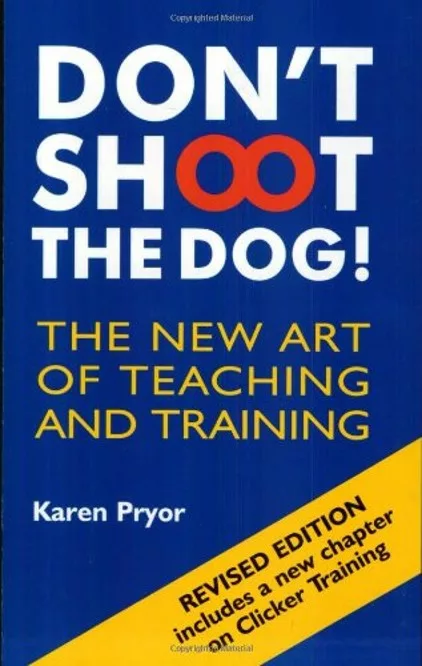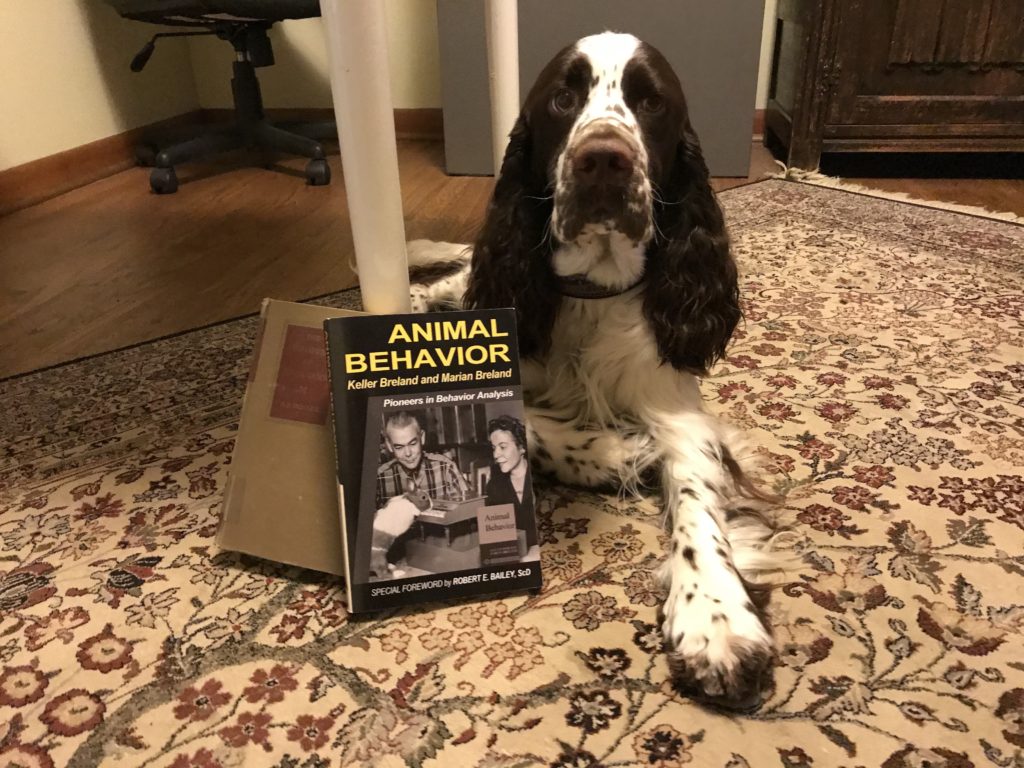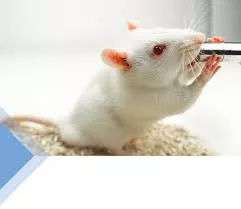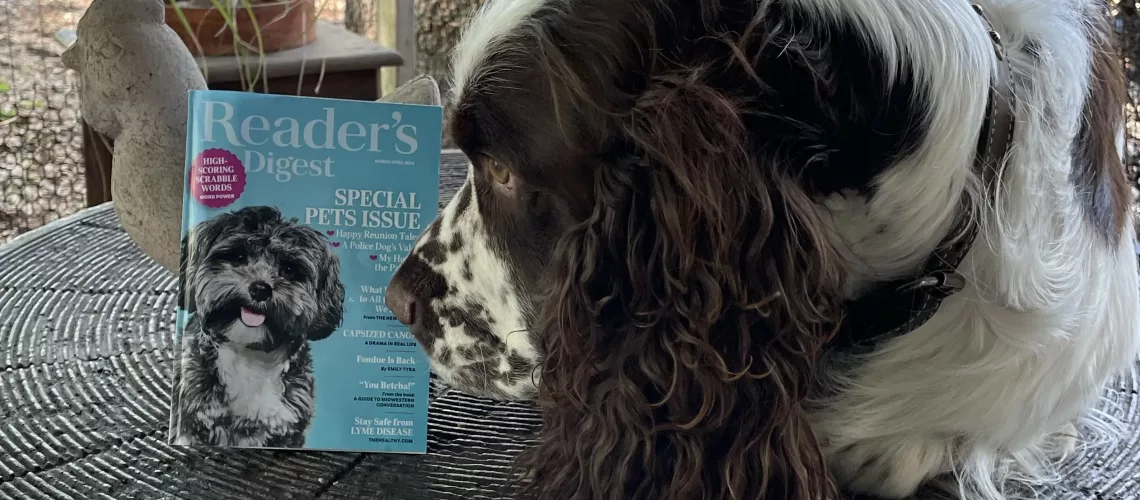My sister read an article about the inspiration that can come from having a dog. Then she asked me some questions about training methods that came up for her while reading. Even though I’m about to pick apart one aspect of the article, it’s a good story about a guy and his dog and well worth reading. It’s in the March-April, 2024 issue of the Reader’s Digest.

Association is a Training Method
A police officer in the K9 division got his first dog and was carefully following instructions to teach the dog that HE was the source of everything good. He was using association to accomplish this but I don’t know if he knew that. Association, Pavlovian conditioning, and classical conditioning are all different names for exactly the same thing; they are something of a “word soup”, but don’t let it confuse you. It’s the learning process by which you connect an emotion with an item or event. For instance, talk about the beach and a smile appears on my face. Pick up your dog’s bowl and he may pant happily, with a wide mouth, and dance around.
Associating Yourself with Good Things
Making myself valuable in my dog’s estimation is a sound lesson, and one I commonly use as well as teach students. The difference is in how the guy was instructed to do it. As my sister described it, he was to offer the dog a bowl of water; if the dog didn’t want to drink it right then, the man was to put it away and offer it again later. The idea was that the owner provided all the good things – water wasn’t simply available at any time the dog wanted to drink.
There’s nothing inherently wrong with this. It did not appear that the guy planned to withhold water to a point where the dog was in distress or danger. However, it gives us insight into the training method and philosophy behind this approach.
Treats: Evidence of Positive Reinforcement as a Training Method
Why not use treats? When I have a new dog in my home, I have training treats available. Period. I wear a treat bag; a bowl of treats adorns my desk; a wall basket is mounted outside my front door with a bag of treats in it; baggies and jars of treats are stashed in strategic locations around the house, where anyone can quickly grab them. I hand out treats when I see behaviors I like. The dog comes over to me, sits, lies down – I give a treat. The dog is looking out a window when a squirrel runs by – I give a treat for choosing to watch calmly without barking. Someone knocks on the door – I give a treat to associate a person at the door with something yummy. The training method in use is making associations I want and reinforcing behaviors I want. It’s what many call positive reinforcement training, but much more is happening.
All those treats are likely to reinforce the behaviors they follow. But they are also associated with me! The water bowl? It’s on the floor, available at all times.
Hydration Needs Fluctuate
Water is necessary for life, and I cannot know when my dog is thirsty; especially if it’s a new dog and I don’t know him very well yet. My dog’s needs for water fluctuate with weather, exercise, stress, diet, health status, and more. Even in the middle of a training session, I am perfectly OK if my dog needs to run over and get a drink. I may have gotten caught up in the training exercise and forgotten to give him a break! He’s free to attend to his bodily needs.
Meal Time is Training Time
Food bowls are different. I don’t leave those down. My dogs get meals twice a day. Technically, dogs may only need to eat once a day; the jury is still out on that. We do know that dogs can even fast for a day! Food is essential but not on the same level or schedule that water is. I can teach dogs that food has great value; it’s something that is worth doing a little work to get! This is a training method in itself and sets my learners and me up for being able to use food to teach other behaviors.
I prefer to feed twice a day because feeding time is valuable training time. Just 60 seconds of practice on a single behavior preceding two meals a day can result in amazing progress! Add to that, a bunch of strategically placed reinforcers throughout the day in the form of treats, toys, and opportunities, and I’m using the same technique the guy in the article was, except I’m doing it with food. Why isn’t that guy wearing a treat bag and giving his new dog treats to reinforce behavior?
Well, we can’t know. However, I’ve been in the dog training world for a VERY long time. My early lessons were based on the use of coercion as a training method to teach animals new behaviors, I have my suspicions.
Training Method Choices Start with Beliefs
Animal training philosophy comes from beliefs and tradition, things that people are typically quite committed to. Chosen training methods come from one’s philosophy. My original dog training education was filled with the ideas of domination and control by force or threat; I believed in those training methods at that time. Honestly, I just wanted to get my dogs to do cool things and I didn’t put much thought into whether these training methods were the best way to get there. But I recognize that those techniques closely matched the way my parents raised children and how I saw people interacting with animals, so they were easy to accept. It took my questioning of the training methods to open up the possibility of a new philosophy for my training journey.
The philosophy I have embraced for the last 30 years or more is based on how animals learn and the immense possibilities that come with respect and care for who animals are and the many ways they can work with us as partners. My training philosophy requires me to make sure the needs of my learners and myself are both met. Now I understand that animals are learning all the time and we have the power to influence what they learn. With more education and experience under my belt, I question what associations a thirsty dog might make that involve me.
Not Wrong, but Probably Not Ideal
Is a dog associating thirst relief with me when I give him water? Or is he associating the discomfort of thirst or the frustration of not being able to meet his biological needs with me? I can’t know this for sure until the associations are developed pretty extensively, past the point of my being able to easily change them. But I can surmise that there are some connections I don’t want that are happening. Besides, it’s just not necessary to toy with the basic essentials of life.
Animals in Top Condition are Ready to Learn
Keeping animals well-hydrated and at a functional body mass are necessary for having a healthy brain to work with in training. You may find older descriptions of keeping animals underweight or hungry in order to use food to train with positive reinforcement, but research over the last 80 years shows that we don’t have to starve animals or reduce their weight to be able to train them with food.
We can certainly use logic in our planning, though. A dog who has just finished his evening meal and is curled up on his bed and sleepy, probably isn’t ready to do a training session. Neither is a chicken whose crop is full! You’ll have to wait a few hours before a training session.
Changes in Training Methods
In the 1980s, after reading Karen Pryor’s 1984 book Don’t Shoot the Dog, my training group and I were trying to get our heads around how to work this “new” way of training into what we were already doing. Well, you cannot “work positive reinforcement into” force training without causing even more problems! You have to choose positive reinforcement based training over coercion.

I did that over the next few years. In the process, I learned that clicker training wasn’t “new”. You have only to read Animal Behavior by Keller and Marian Breland, published in 1966, to know that. Karen Pryor did the world a huge favor by popularizing “clicker training”, but the Brelands had been using it since the 1940s and B.F. Skinner discovered the value of markers, bridges, or clickers in the 1930s. Another “word soup”, markers, bridges, and clickers all serve the same purpose – to mark a behavior that will be reinforced.

Comprehensive Training Methods
When dogs love training, it doesn’t much matter when they last ate (as long as we don’t do strenuous activities on a full stomach) because they associate every part of training with every other part and are enthusiastic to join in. This includes the behaviors they perform, the location and equipment, the trainer, treats and other reinforcers, and more. Positive reinforcement training helps dogs learn that their choices, the behaviors they perform, get them things they like. This is the basis of understanding operant conditioning and where the power we have as trainers to change behavior comes in.
The Impact of Consequences in Training
This brings us back to our police dog trainer. I understand where he was coming from. I believe he loved his dog and wanted to do his best to train him well. Association is a powerful way of learning. But it is also important to understand how to use consequences to teach. The article did not mention what the dog did just before the man offered him water, and that matters.
Lab Rat Training Methods
Water is often used in training laboratory rats in the behaviors needed for experiments. Personally, I don’t care for this approach even though valid scientific studies have documented the amount of water a healthy rat needs and how long the rat can wait for water before having physiological problems from deprivation. I think trainers in the lab may simply find it easier to reinforce behaviors with water.

Skinner Trained Rats with Food Reinforcers
Depriving animals of water just makes me cringe for the reasons I mentioned previously. Besides, B. F. Skinner used food to train rats and did just fine! If you ever read his fundamental book, The Behavior of Organisms, you’ll see that the learning curves he obtained didn’t come from statistical analysis; he actually did enough experiments to establish beautiful curves from raw data – that happened to amaze me when I read the book. (It’s a terribly challenging book to get through and I am not necessarily recommending it. But it increased my respect for Skinner’s work.) On a side note, Skinner had to make his own pelletized rat food in his lab. They didn’t have Rat Chow in the 1930s. The work that went into his discovery of operant conditioning is incredible to think about.

Associations and Consequences Happen at the Same Time
But I digress! When the guy in the article gave his dog water, the water not only became part of an association, but was most likely reinforcing a behavior that had just occurred. What was the dog doing when the man gave him the water? Whatever it was, that was the behavior that the water reinforced. Did the guy even know that? It’s not mentioned in the article, just as association is not mentioned. It seems like the technique of withholding water may be a tradition among the trainers he worked with. It’s possible that no one really gave any thought to the goal, plan, or method or whether this was the best way to accomplish the task.
Awareness of Training Method
The point is not necessarily the guy needing to ask his dog to sit or lie down before giving water, although he could certainly do that. What matters is what the dog was doing – both internally and externally. Was he standing calmly, waiting to be given the water? Or did the pup just happen to sit to politely “ask” for some water? Being an adolescent dog, he could have been overly excited due to thirst and lack of self-control, possibly jumping on the guy and splashing water out of the bowl. I don’t have any way to know this, but it’s possible – ever been around a young dog? LOL In that case, the water reinforced not only the external jumping and bouncing but also the pup’s internal state of excitement and urgency.
Positive Reinforcement
The water was not only a device of association but a consequence the man had control of at that moment. He had the opportunity to use it to reinforce any behavior he chose. That’s what positive reinforcement is: providing a consequence following a behavior that causes that behavior to happen more often in the future. In this light, we consider that a dog who wants a treat, or a drink of water, and gets that desired item when he does a certain behavior, will do that behavior again in the future. It seems like common sense when you understand it, but it has also been documented in scientific research for nearly 100 years.
Training Methods Dictated by Tradition
Here’s the bottom line: Why didn’t the guy just wear a treat bag and hand out treats when his new dog was doing things he liked? Because he didn’t know how? More likely, because his belief system, the guidance he got from his mentors or his boss at the police station, the traditions of animal training he was familiar with, told him that training with food is bad. There’s a long list of arguments. I’ve heard all these and more.
- “The dog will only do it when you have food.”
- “The dog won’t learn that he ‘has to’ do the behavior.”
- “You won’t have control when the dog isn’t hungry.”
- “The dog will beg for food all the time.”
Dogs Are Always Learning; Be Careful What You Teach
These beliefs are accurate if one uses positive reinforcement incorrectly or incompletely, or if one has poor observation or reinforcement skills. It’s easy to teach a dog that when you’re wearing a treat bag, he gets treats. It requires more skill to finish the job. Achieving fluent behavior means the dog just does it; he doesn’t think about it or consider his options, he just does it every time. It’s part of his behavioral repertoire and he honestly can’t help doing it because it’s so deeply ingrained in his brain that his neural pathways lead him there.
Fluency in Human Behavior
When you get into your car, do you think through all the things you’re going to do to get it started and on the road? Nope. You perform a series of behaviors – a chain of behaviors in the same sequence every time, depending on the car and its layout. Close the door, maybe adjust your seat, do a series of actions to start the car, connect your phone or turn on the radio, maybe map your destination, maybe put on your sunglasses, do something with the shifter depending on the car, and drive. You carry out these actions without thinking. If someone came along and asked you to do some of the things in a different order, you’d find it difficult because you are fluent at using this process to drive your car. It’s easy, it just happens, and you don’t do it in order to get a cupcake.
My sister, who brought up this topic, is a musician. She is fluent at playing her instruments. When she sits down on a piano bench, she doesn’t think – she plays. She had to learn through stages during which she had to think and practice new behaviors, train her hands to do what was necessary to get the music she wanted. But now, her brain expertly drives her hands when she begins playing. Stopping to think about what key her left ring finger is on would shut down the piece she was playing. That’s what fluency looks like.

What Behaviors Does Your Dog Perform Fluently?
Your dog has a behavioral repertoire that he’s fluent at, too. Some things are innate such as his process of scratching up his bed to get ready for sleep or his potty habits. Maybe you’ve successfully taught him some tricks or a series of polite behaviors while putting his leash on for a walk – kudos if so! With positive reinforcement training, you can produce behaviors that are as fluent as those he was born with. You don’t need deprivation as a training tool. You just need good observation skills, an understanding of how dogs learn, and strong reinforcement and decision-making skills.
I am not accusing anyone of doing bad things. I’ve been around the block a couple of times and trained both ways. I have a pretty good understanding of how animals learn and how to train in the most efficient and effective way while ending up with a dog who loves to work with me.
Be the first to read our monthly educational and inspirational blog posts, best enjoyed with a cup of coffee or your favorite relaxing beverage. Subscribers also receive a monthly post with a training application you can put to use with your own dog, right away. Sign up for our mailing list at the bottom of this page!


